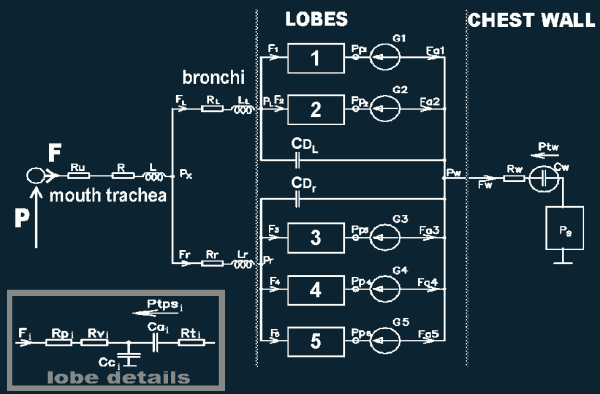Selected details
Auto-limitation of air flow through collapsible bronchi during forced expiration is of key meaning in spirometry. This airflow is describes with the following formula being the resolution of a differential equation (details in [3]):

where:
- f — airflow,
- Pb — the pressure inside those bronchi,
- Pa — alveolar pressure (approximately — see [3]),
- Pp — intrapleural pressure outside the considered lobe,
- k i b are constant parameters characterizing a patient.
Parameter k is approximately equal to airway resistance at the end of extremely deep inspiration, i.e. when lungs are expanded maximally and there is no airflow. The value of this parameter is connected with the lumen of bronchi and can be changed with the Slider R(1/Lumen) in the Tol.e-spirometry system.
Parameter b is approximately connected with elastic properties of the bronchi wall. Physicians who tested the Tgol.e-spirometry system have suggested to make the parameter ‘invisible’ (however, his place in the table of parameters retains to make possible to show it if an user will request it).
The original formula from [3] that connects lungs volume (Va) with the static transpulmonary pressure (Ptps) has been modified to make simple physiological (medical) interpretation of formula parameters. In the Tgol.e-spirometry, Va and Ptps are connected with the following formula:

where:
- Size — the parameter that can be interpreted as the size of lungs,
- Compl — the parameter that plays role of unitary compliance of lung parenchyma.
The values of both parameters can be changed in the Tgol.e-spirometry system.
Dependence of the chest volume (Vw) on the trans-wall pressure (Ptw) is described with the following formula:

where parameters C1, C2, and C3 characterize a patient. They are not ‘visible’ in the Tgol.e-spirometry system. Modification of their values, e.g. when patient’s height is changed, is strictly connected with the parameter Size.
The part of dead space that collapses during forced expiratory maneuver is described by means of a computer procedure with several parameters. This part, as the whole dead space, is important when ventilation or blood oxygenation is analyzed (alveolar ventilation is equal to minute ventilation minus dead space ventilation) but it has not big significance in spirometry. Nevertheless, the specific shape of the flow-volume curve in the case of severe obstructive lungs disease cannot be explained without that collapsible dead space. Therefore, the user of Tgol.e-spirometry system should have possibility to manipulate properties of that space with at least one slider (it should be realized that since there are several parameters and one slider, the simulation may not be very accurate sometimes).
Connection of all equations and procedures into one ‘alive’ complex may be illustrated with the following simplified scheme:


where, for example, Rp represents the formula determining airflow through collapsible bronchi and Cm represents mediastinum compliance.
